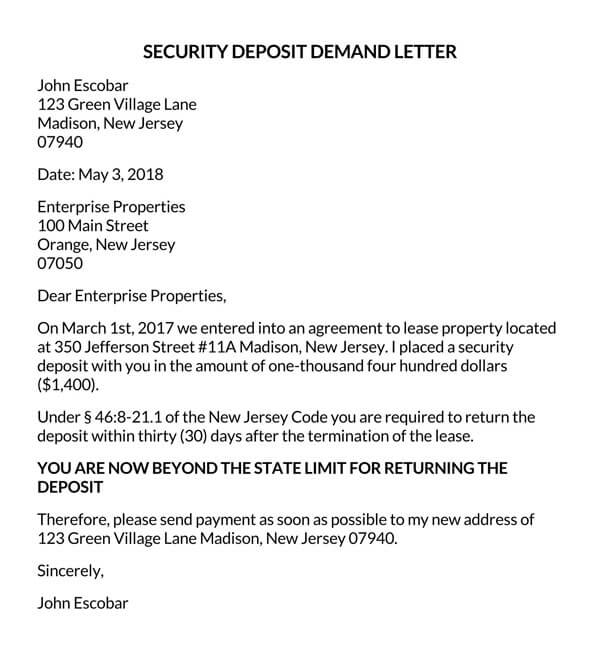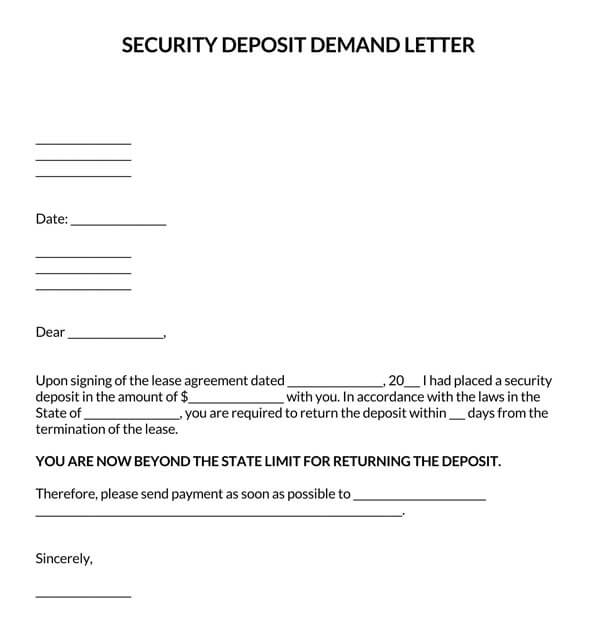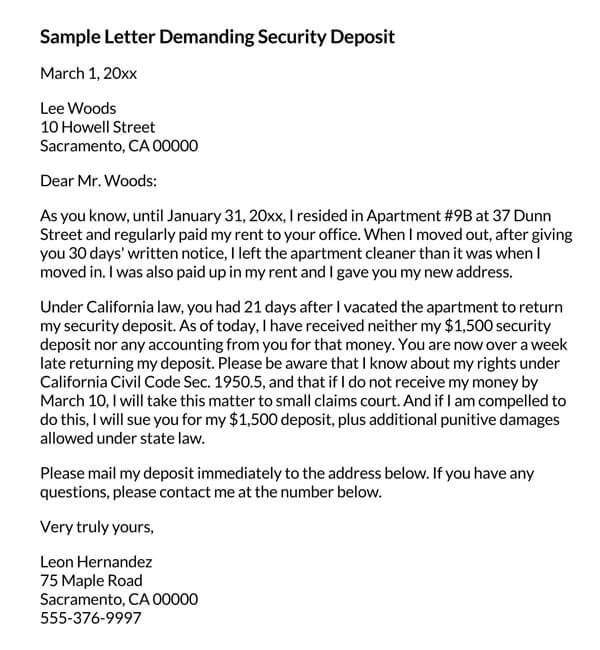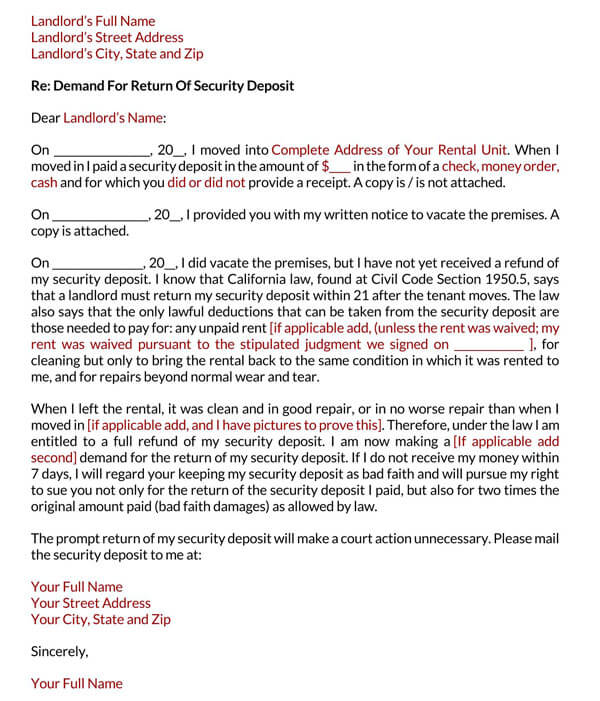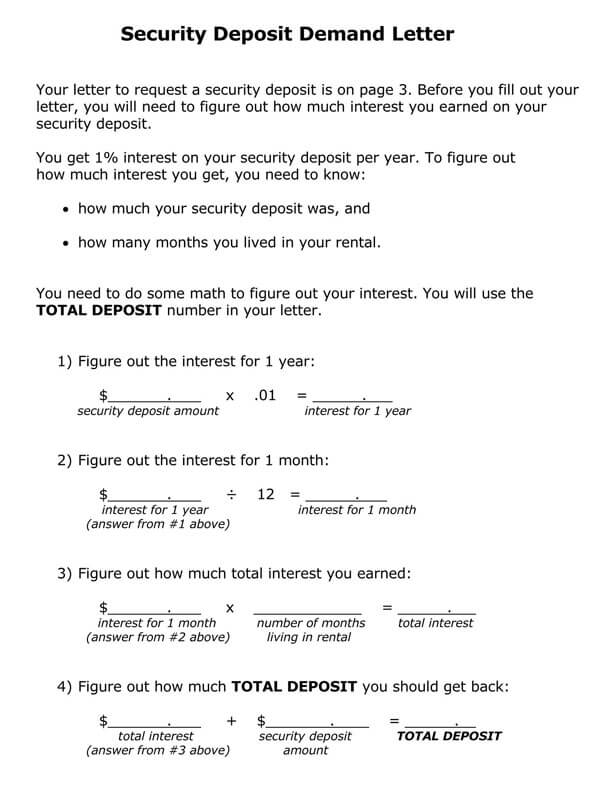A Security Deposit Demand Letter is an official document sent to landlords by their tenants, demanding a refund of money paid at the start of the tenancy as proof of an intent to move in and care for the property as stipulated in their lease agreement.
A tenant can only send a security deposit demand letter once the lease term ends and significant time has passed without a refund of the security deposit by the landlord.
The security deposit demand letter is proof of the communication about the security deposit between the tenant and the landlord should the tenant need to take legal action in a small claim’s court.
Tenants must ensure that their situation warrants a requirement to write a security deposit demand letter. If the security deposit has not been returned in full, including interest, tenants can write and send the security deposit demand letter three weeks after their tenancy ends.
Tenants can also write a security deposit demand letter if the landlord only returns part of the deposit without a letter explaining the deduction. In this case, the tenant will write the letter demanding an explanation from the landlord as to why the rest of the deposit has not been refunded.
Tenants can also write this letter to request an explanation from the landlord regarding why they have not sent a letter communicating their reason for not refunding the security deposit. Such a demand letter focuses on requesting communication by the landlord concerning the refund of the security deposit.
Security Deposit Demand Letter Templates
Following are some free downloadable templates for you.
Standard Templates
By State
Types of Security Deposit Demands
The security deposit demand letter should contain the tenant’s demands concerning the refund requested by them. The demands made by the tenant may vary depending on the actions taken by the landlord that may have affected the refund of the security deposit. These demands include:
After tenancy
Upon the end of tenancy, a landlord is obligated to return the security deposit. Suppose the landlord has not refunded the tenant by the state indicated period, then the tenant can demand a refund through the security deposit demand letter.
Did not place in a separate account
A tenant can write a security deposit demand letter demanding that the security deposit is placed in a separate account depending on the state of residence.
Failed to transfer to a new owner
A tenant can write a security deposit demand letter requesting the former property owner to transfer the security deposit to the new owner. This will prevent the tenant from paying a new security deposit amount to the new owner.
No receipt
Depending on the state of residence, the tenant can write the security deposit demand letter to the landlord requesting a security deposit receipt.
No checklist
A tenant can write a security deposit demand letter requesting the landlord to write a checklist detailing what needs to be done before moving out of the property to secure their security deposit refund. This is, however, dependent on the tenant’s state of residence
How to Request a Security Deposit
The tenant must ensure that they follow a step-by-step process when requesting the return of the security deposit. The following procedure can help guide the tenant:
Check state laws
A tenant must first find out the stipulated period a landlord has to return the security deposit. This can be achieved through verification of the state Security Deposit Return Laws. Then, based on the period stipulated, a tenant can discern how long they should take before writing a security deposit demand letter.
Write the letter
Once the tenant has established that the state stipulated period has passed, they can then write the security deposit demand letter. The tenant must ensure that they have the landlord’s name, address, the original lease, and a valid reason for writing the security deposit demand letter.
Send the letter
A tenant should then send the security deposit demand letter via certified mail. The tenant can also use a service that provides a receipt upon delivery. Keeping a copy of the letter and receipt ensures that the tenant has proof of delivery. The demand letter is recommended because the landlord will likely take the letter more seriously than an email. However, a tenant can send a follow-up email of a PDF version of the letter to ensure that the landlord receives it.
Wait for a response
Finally, the tenant should wait for a response from the landlord. In most cases, the landlord will return the security deposit upon receiving the security deposit demand letter or explain why it will not be returned to the tenant. However, if the tenant does not receive a response in 30 days, they can take further action in a court of law.
What to Include
A tenant must ensure that they provide detailed information in the security deposit demand letter. The information provided by the tenant will ensure that effective communication is established with the landlord. This information includes:
Include your personal information
When writing the security deposit demand letter, the tenant should ensure they provide their personal information. The information the tenant must provide includes their name, current address, and contact details. This information will enable the landlord to reach the tenant when making their response concerning the security deposit.
Include landlord’s details
The tenant should also include the landlord’s name and address to ensure that they receive the security deposit demand letter. Including the landlord’s detail will also prove that he/she was contacted to return the security deposit before the tenant decided to take legal action.
Complete address of the rental place
The tenant should include the address of the former rental property. This will help the landlord identify, for example, the apartment unit the tenant resided in and paid the security deposit for.
Security deposit amount
The tenant must also include the security deposit amount to help clarify to the landlord the funds to be returned. The amount sought by the tenant may be equivalent to the first month’s rent or more, depending on the state of residence.
Date when the security deposit was paid
The tenant should also include the date the deposit was paid to the landlord. Even when the tenant cannot remember the exact date, they should ensure the month the deposit was made is correctly indicated. This ensures that the security deposit is easily traced.
The date when the tenancy ended
The tenant must provide the date the tenancy ended; this is because a security deposit refund can only occur once the lease term comes to an end. However, it is essential to note that the date stated does not have to be the day the tenant moved out.
State reason for security deposit demand
The tenant should also explain why they are requesting a refund of the security deposit. This will strengthen the tenant’s claim for a return of the security deposit. It will also ensure that the landlord is well informed in the security deposit demand letter.
State laws that require a return of the deposit
The tenant should mention specific state laws that support their claim for the security deposit to be returned. This helps ensure that the claim for a security deposit refund falls within the state’s legal framework.
Penalties for not returning the deposit
The tenant must also include penalties should a landlord decline to return the security deposit or respond to the demand. Penalties can consist of a legal course of action the tenant will undertake after a stipulated period.
Deadline for the payment of the security deposite
The tenant should state a deadline for the refund of the security deposit to be made. The timeline should be enough for the landlord to return the funds or provide a correspondence explaining the deductions, that is if any.
Address where the landlord should send the deposit
The tenant should also provide the landlord with an address that they can use to send the security deposit. The information should also include the account number the funds should be deposited.
Final warning
The tenant should provide the landlord with a clear warning stating that should the landlord fail to either respond to the security deposit demand letter or return the security deposit, they will file a formal lawsuit. Stating this in the security demand letter will ensure the landlord takes the demand seriously.
Important Considerations
Writing a security deposit demand letter can help communicate a tenant’s demand to a landlord officially and concisely. The tenant can consider the following suggestions before and during the writing of the security deposit demand letter:
- The tenant can call the landlord before writing the security deposit demand letter or write an email in a bid to solve the matter informally.
- When writing the security deposit demand letter, the tenant should ensure the letter is brief and straight to the point.
Conclusion
A tenant who adheres to a landlord’s lease terms before, during, and after the tenancy is entitled to a security deposit refund. Once the lease terms come to an end, a tenant can claim the security deposit. Suppose the landlord does not refund the deposit to the tenant after a state stipulated period. In that case, the tenant can write the security deposit demand letter requesting the refund before seeking legal action.
